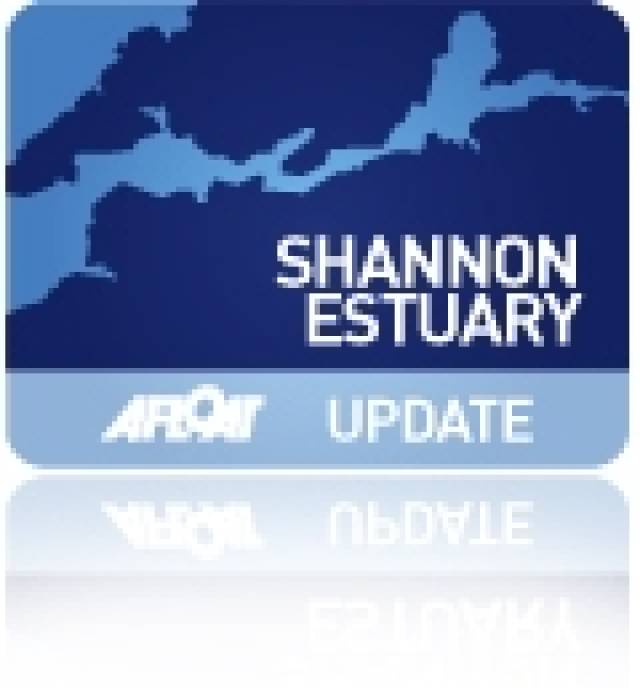#BuoyTender - Puffin, a former Commissioners of Irish Lights (CIL) buoy-tug tender which spent a career of almost three decades in Dun Laoghaire Harbour has recently been spruced up in new colours for current owners Shannon Workboats, writes Jehan Ashmore.
Puffin was very much a 'workhorse' for Irish Lights Dun Laoghaire based marine depot from where the vessel towed countless buoys back and forth to the various anchored 'lighthouse' tenders among them Atlanta, Granuaile and Gray Seal.
Arguably such workhorses can be easily forgotten or disregarded in a task perhaps perceived as mundane yet the role of the Puffin was an integral component in ensuring the operations of CIL.
The work of Puffin was vital bearing in mind the countless aids to navigation that dot around our island to assist safe passage not just to seafarers and ship cargoes but also passengers and leisure users too.
The Commissioners had Puffin custom-built from David Abels Boatbuilders of Bristol in 1984. It is understood that the small vessel of 12.4m long, beam of 3.8m and 1.5m draught was the last vessel launched from the Albion Dockyard.
When she was sold in 2011, the 24 gross tonnes vessel made her repositioning delivery voyage from Dun Laoghaire to the Shannon Estuary. The first leg to Baltimore took more than 30 hours and from where she took on bunkers before continuing on the final 20 hour-leg to Foynes.
She alongside Shannon Workboats fleetmate Islander are 'lines-boats' contracted to Rusal Aughinish Alumina, the largest alumina processing plant in Europe. Both workboats provide assistance in transferring mooring ropes between bulk-carriers docking and departing the double berth jetty.
The outer 285m berth can handle 90,000dwt vessels at depths of 12.4 metres and the inner 180m berth is for 40,000dwt ships in waters of 11 metres.
Examples to the type of bulk-carriers both large and small calling to Aughinish Jetty as previously reported on Afloat.ie are the 2009 Japanese built Panama-flagged Aom Julia, the 76,596dwt which was discharging bauxite. On the adjacent berth the South Korean built Arklow Mill of 14,990dwt was loading alumina bound for Rotterdam.
The plant's production process involves extracting alumina from imported bauxite that is discharged at the jetty. Approximately 70% of the bauxite originates from Guinea in west Africa and the balance from Brazil. The alumina (totalling 1.924m tonnes in 2012) is discharged from the same jetty for export where it is processed again through smelting into aluminium metal.
The lighthouse vessels are now referred as aids to navigation tenders with the current vessel the 2000-built ILV Granuaile. The 2,635 gross tonne vessel continues to anchor within the harbour's western bight off the West Pier. Instead of the Puffin, the towage of buoys continues to be maintained by smaller sized tenders belonging to the ILV Granuaile.
On a few occasions each year due to Spring tides, this procedure is not required as ILV Granuaile can moor alongside the berth at CIL's joint administration and marine depot.
Among the other tasks Puffin was gainfully employed was in the towage of the larger navigational aids such as Superbuoys and Large Automated Navigation Buoy's (LANBY). In 2010 Afloat.ie reported on the last LANBY.
In addition Puffin was not exclusively confined within the harbour as she would be required to transfer maintenance personnel to the automated Kish Lighthouse and Muglins lighthouse off Dalkey Island.
Her aft deck can handle up to 5–tonnes capacity and has proved useful. For example she loaded dismantled parts no longer required within the structure of the Kish Lighthouse and taken to Dun Laoghaire Harbour.
Puffin not only retains her original name but also her port of registry – Dun Laoghaire which is certainly most unusual to see for a vessel that is not a pleasure craft or yacht.
With the removal of Puffin's former CIL livery of grey hull colour and buff funnel, which also applied to the lighthouse tenders, the last been in this guise was the 1970 built Granuaile.The 2,003grt vessel as previously reported on Afloat.ie serves as Ocean Seeker for Gardline Marine Services based out of Great Yarmouth on the UK's Norfolk coast.
The current 'Granuaile' sports a blue hull likewise to her former fleetmate... the Puffin!
































































